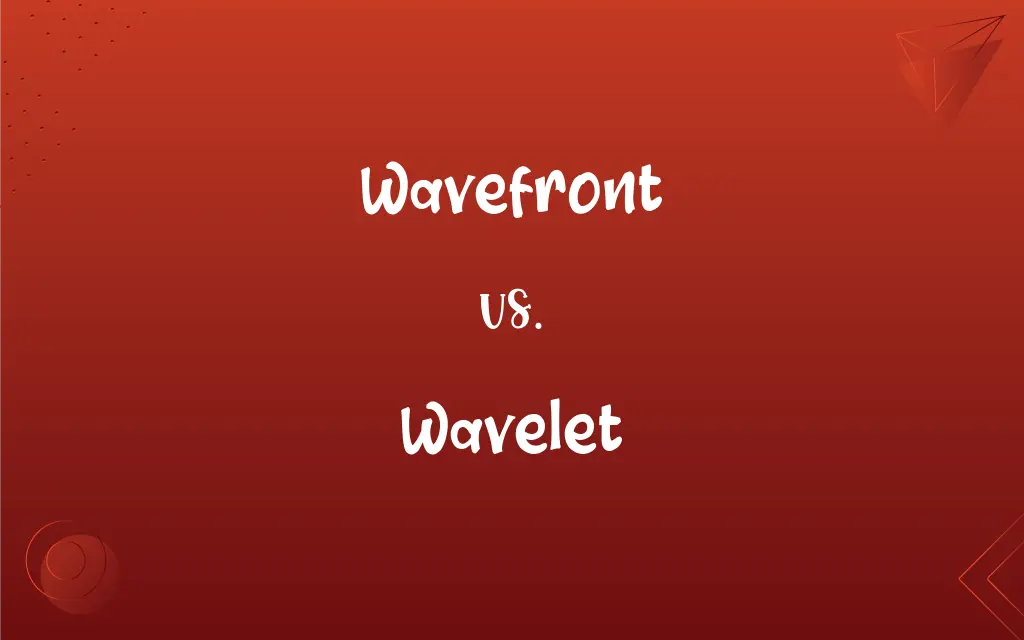Wavefront vs. Wavelet: What's the Difference?
Edited by Aimie Carlson || By Janet White || Published on February 19, 2024
Wavefront refers to a surface over which a wave has a constant phase, while a wavelet is a small, localized wave, especially one of a series that is part of a larger wave.

Key Differences
Wavefront is a concept describing the shape of the propagation front of a wave, which can be planar, spherical, or of different geometries, depending on the source and medium. Wavelet, in contrast, is a small or brief wave that is part of a larger wave, often used in signal processing and analysis.
The term wavefront is used to describe the entire surface of a wave at a specific point in time, emphasizing the uniform phase across that surface. Wavelet emphasizes the small-scale, transient nature of the wave, often used in analyzing complex waveforms like seismic data or heart rhythms.
Wavefronts are essential in understanding wave propagation, interference, and diffraction, with applications in optics and acoustics. Wavelets are fundamental in wavelet analysis, a method for decomposing signals into components with varying frequency and location.
In wavefront analysis, the focus is often on the shape and behavior of the entire wave as it moves through space. In contrast, wavelet analysis involves examining small, localized waves within a larger wave, often to extract information or identify patterns.
The concept of a wavefront is used in describing phenomena like light rays bending (refraction) or spreading out (diffraction). Wavelets are used in digital signal processing, image compression, and solving differential equations where localized wave behaviors are important.
ADVERTISEMENT
Comparison Chart
Definition
Surface over which a wave has constant phase
Small, localized wave in a larger wave
Focus
Shape and propagation of entire wave
Small-scale, transient aspects of a wave
Applications
Optics, acoustics, wave propagation
Signal processing, data analysis, compression
Analysis
Emphasis on uniform phase and propagation
Focus on decomposition into varying components
Typical Use
Understanding wave behavior in mediums
Extracting information from complex waveforms
ADVERTISEMENT
Wavefront and Wavelet Definitions
Wavefront
The leading edge of a moving wave.
Scientists studied the wavefront to understand the spread of sound in water.
Wavelet
A brief or localized oscillation within a larger wave pattern.
Each wavelet in the signal was analyzed for frequency content.
Wavefront
The line or surface forming the boundary of a wave as it propagates.
The planar wavefront is commonly observed in uniformly distributed waves.
Wavelet
A tool in signal processing for analyzing various components of a signal.
Wavelet transforms are used in image compression techniques.
Wavefront
A representation of the phase distribution of a wave.
Wavefront analysis is crucial in advanced astronomical telescopes.
Wavelet
A small wave used in mathematics and physics to describe a brief oscillation.
Wavelets are essential in breaking down complex sound waves into simpler forms.
Wavefront
A surface over which a wave has a constant phase.
The wavefront of the light was distorted by the lens.
Wavelet
A component of a complex waveform, characterized by its short duration.
The cardiac signal was decomposed into wavelets for detailed study.
Wavefront
A conceptual surface representing points of a wave that are in phase.
The wavefront's curvature helped determine the focal point in optical systems.
Wavelet
A small, brief wave, particularly as part of a larger wave.
The wavelet analysis revealed hidden patterns in the seismic data.
Wavefront
The continuous line or surface including all the points in space reached by a wave or vibration at the same instant as it travels through a medium.
Wavelet
A small wave; a ripple.
Wavefront
(physics) An imaginary surface passing through points of a medium oscillating in phase.
Wavelet
A small wave; a ripple.
Wavefront
(physics) an imaginary surface joining all points in space that are reached at the same instant by a wave propagating through a medium
Wavelet
(mathematics) A fast-decaying oscillation.
Wavelet
A little wave; a ripple.
Wavelet
A small wave on the surface of a liquid
FAQs
Are wavefronts related to the speed of wave propagation?
Yes, wavefronts represent the movement of waves through a medium.
What is the main purpose of wavelet transforms?
To analyze different frequency components of a signal at various scales.
Can wavelets be used for image compression?
Yes, wavelet transforms are effective in compressing images by focusing on essential data.
Can wavefronts be observed in everyday life?
Yes, examples include ripples on water or light rays through a lens.
Is the wavelet theory a recent development?
Wavelet theory has gained prominence in the last few decades.
What is a wavefront in physics?
A wavefront is the surface over which a wave maintains a constant phase.
Can wavefronts be curved?
Yes, wavefronts can be planar, spherical, or of various shapes based on the wave source and medium.
What is a planar wavefront?
A planar wavefront is a flat surface where all points of the wave are in phase.
Can wavelets represent any type of wave?
Yes, wavelets can represent various types of waves, including sound, light, and seismic waves.
How are wavelets used in data analysis?
Wavelets decompose complex signals into simpler parts for detailed analysis.
How does wavefront analysis benefit optics?
It helps in understanding light propagation, refraction, and focusing in optical systems.
Are wavelets useful in digital communications?
Yes, for analyzing and processing complex signal data.
Can wavelet analysis detect anomalies in signals?
Yes, it's effective in identifying irregularities or changes in signal patterns.
Do wavefronts change in different mediums?
Yes, the shape and speed of wavefronts can change based on the medium they travel through.
Are wavelets always part of a larger wave?
Yes, wavelets are small oscillations or segments within a larger wave.
Are wavefronts important in laser technology?
Yes, understanding wavefronts is crucial for focusing and directing laser beams.
How does wavelet analysis handle non-stationary signals?
Wavelets can adapt to varying signal frequencies, making them ideal for non-stationary signal analysis.
Is wavefront analysis used in astronomy?
Yes, especially in telescopes to correct for distortions in incoming light.
What fields benefit from wavelet analysis?
Fields like signal processing, seismology, and biomedical engineering.
How do wavefronts relate to sound waves?
Sound waves propagate through mediums, creating wavefronts that represent the wave's phase.
About Author
Written by
Janet WhiteJanet White has been an esteemed writer and blogger for Difference Wiki. Holding a Master's degree in Science and Medical Journalism from the prestigious Boston University, she has consistently demonstrated her expertise and passion for her field. When she's not immersed in her work, Janet relishes her time exercising, delving into a good book, and cherishing moments with friends and family.
Edited by
Aimie CarlsonAimie Carlson, holding a master's degree in English literature, is a fervent English language enthusiast. She lends her writing talents to Difference Wiki, a prominent website that specializes in comparisons, offering readers insightful analyses that both captivate and inform.
































































